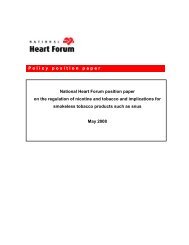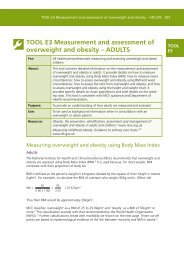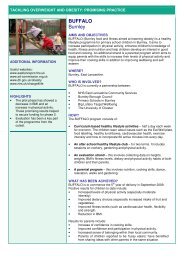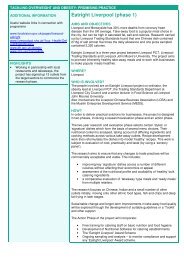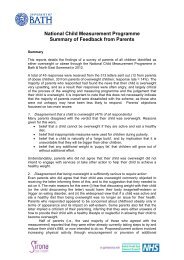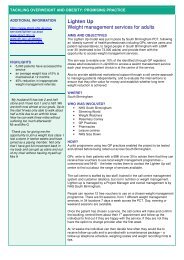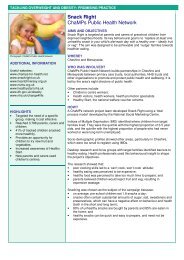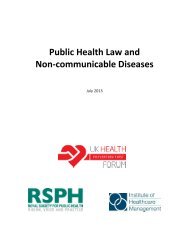The Challenge of Non-Communicable Diseases and Road Traffic ...
The Challenge of Non-Communicable Diseases and Road Traffic ...
The Challenge of Non-Communicable Diseases and Road Traffic ...
You also want an ePaper? Increase the reach of your titles
YUMPU automatically turns print PDFs into web optimized ePapers that Google loves.
3. THE DRIVERS AND<br />
DETERMINANTS OF NCDs<br />
Changes in the magnitude <strong>and</strong> distribution <strong>of</strong> the<br />
risk factors <strong>and</strong> determinants for NCDs, alongside<br />
demographic change <strong>and</strong> economic development,<br />
are driving the trends in the disease burden [24, 35,<br />
77]. In considering the question, “What determines<br />
<strong>and</strong> drives the NCD <strong>and</strong> RTI burden, <strong>and</strong> what are<br />
the commonalities with communicable diseases?”<br />
this section covers:<br />
• NCD risk factors in SSA (nutrition, tobacco, alcohol,<br />
<strong>and</strong> physical activity <strong>and</strong> travel);<br />
• <strong>The</strong> drivers <strong>of</strong> NCD trends (growing urbanization<br />
<strong>and</strong> the impact <strong>of</strong> demographic changes);<br />
• Socio-economic determinants <strong>and</strong> distributions;<br />
<strong>and</strong><br />
• Commonalities between NCDs <strong>and</strong> other risk<br />
groups.<br />
3.1. NCD Risk Factors<br />
Over the period 1990-2010 globally <strong>and</strong> in Sub<br />
-Saharan Africa, there has been a shift in the contribution<br />
<strong>of</strong> different risk factors to the disease burden<br />
away from risks for communicable diseases in children<br />
towards those for non-communicable diseases<br />
in adults [78]. Leading risk factors for SSA regions<br />
in 2010 can be found in Table 4. In 2010 in Central,<br />
Eastern, <strong>and</strong> Western SSA, childhood underweight,<br />
household air pollution from solid fuels, <strong>and</strong> suboptimal<br />
breastfeeding continue to be leading causes <strong>of</strong><br />
disease, but their contribution to the disease burden<br />
has fallen substantially since 1990. A much larger<br />
share <strong>of</strong> the disease burden can be attributed to risk<br />
factors for NCDs <strong>and</strong> injury, most notably alcohol<br />
use <strong>and</strong> high blood pressure. Since 1980 mean blood<br />
pressure has been stable or been increasing in most<br />
African countries: by 2008, the prevalence <strong>of</strong> raised<br />
blood pressure 6 in the WHO African Region, at 36.8<br />
percent (34.0-39.7 percent) <strong>of</strong> adults aged 25 years<br />
<strong>and</strong> over, was highest <strong>of</strong> any region [79]. In Southern<br />
SSA in 2010, alcohol use was the leading risk factor,<br />
followed by high blood pressure <strong>and</strong> high body mass<br />
index, with smoking also in the top five.<br />
Nutrition<br />
Countries in SSA are undergoing a nutrition transition<br />
[80]. More than half <strong>of</strong> them are still at an early<br />
stage, experiencing a high prevalence amongst children<br />
<strong>of</strong> stunting or being underweight for their age,<br />
a low prevalence <strong>of</strong> overweight <strong>and</strong> obesity amongst<br />
women, <strong>and</strong> low intakes <strong>of</strong> energy, protein, <strong>and</strong> fat.<br />
For a few countries, changes in dietary patterns<br />
are affecting health outcomes in a large portion <strong>of</strong><br />
the population; for example, South Africa, Ghana,<br />
Gabon, Cape Verde, <strong>and</strong> Senegal have relatively<br />
high levels <strong>of</strong> obesity/overweight, <strong>and</strong> low levels <strong>of</strong><br />
underweight in women, as well as high intakes <strong>of</strong><br />
energy <strong>and</strong> fat. In several countries, overweight <strong>and</strong><br />
obesity have reached substantial proportions with<br />
levels <strong>of</strong> 30-50 percent amongst adults <strong>and</strong> higher in<br />
women [81]. Among a sample <strong>of</strong> recent mothers in<br />
31 SSA countries more women were overweight or<br />
obese than underweight (Figure 10) [82].<br />
Where measured, cholesterol levels are generally<br />
low except for the wealthier countries such as Mauritius,<br />
where elevated cholesterol levels have been seen<br />
in 30 percent <strong>of</strong> the population [49]. A high intake<br />
<strong>of</strong> sodium is common in SSA, with salt being used to<br />
preserve food <strong>and</strong> add taste [83], but salt intake generally<br />
does not make the 15 top-ranked risk factors<br />
for attributable disease burden in SSA regions.<br />
6 Systolic blood pressure (SBP) <strong>of</strong> 140mmHg or above or diastolic<br />
blood pressure (DBP) <strong>of</strong> 90mmHg or above.<br />
21



